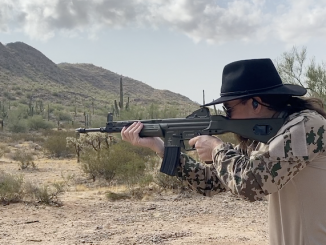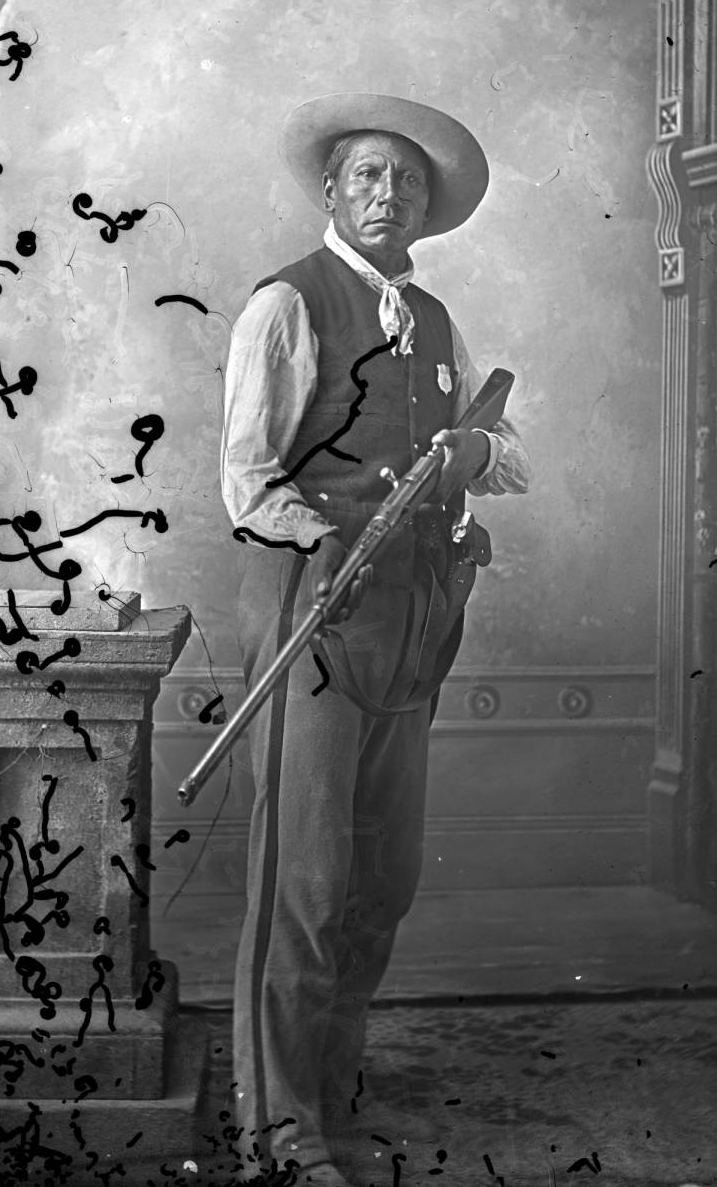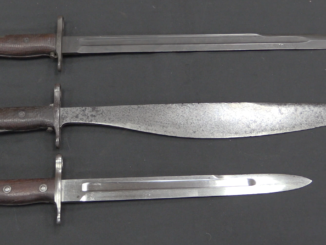These Thompsons are all being sold by Morphys on October 30, 2018: Model 1921 (transferrable), Model 1921/28 overstamp (transferrable), and M1A1 (pre-86 dealer sample).
Having gone through the whole series of Thompson submachine guns, not it’s time to take them out to the range! I was quite curious to see how the different variations would handle side by side, since they have several significant differences. The Cutt’s Compensator and the changing rate of fire can both be expected to have a noticeable impact on the shootability of the guns.
I went in expecting to prefer the World War Two M1A! pattern, and was rather surprised to find myself actually liking the 1921 model best. It’s very high rate of fire actually worked very well, with less noticeable vibration and sight disruption than either of the other types. Its sights are close to useless, and it is both heavy and awkward to handle – but I can see why it developed the following it has!




Worst.Gangster.Impression.Ever.LOL
Lets hope he doesn’t shoot any lever actions.
“ Take it easy Pilgrim “…….
I already linked that, but this article from 1933 has many interesting bits [all page numbers I gave according to pdf’s numeration]
https://scholarlycommons.law.northwestern.edu/cgi/viewcontent.cgi?article=2366&context=jclc
Page 7
The original Thompson sub-machine gun had but eleven parts.It was purely experimental and handled the .22 long rifle cartridge.The early guns manufactured for release, both the hand-made modelsturned out at a Cleveland plant, and the production run built by Colt,contained the same number of parts as the present models-thirty-eight, including all pins, screws, and what-nots
So it sounds similar to OWEN machine carbine, which designer also started with .22 rim-fire cartridges. Notice that on same page author emphasize:
Everything that is necessary can be dismantled by one person without the aid of a tool!
So apparently back then it was uncommon feature.
Page 8 – states “H” is made from titanium aluminum bronze an alloy selected for the obvious reasons of co-efficient of friction, strength, toughness, resistance to wear, and others. – is that true? Does anybody know actual percent of each metal in that alloy?
Page 9 – possible source of firing without H myth
However, Thompson engineers state that the action is built sufficiently strong to resist the slam of the bolt even though the locking surfaces were removed entirely.
[notice: surfaces not whole H]
Page 9 – However, the most effective fire rate, asdetermined experimentally and released as the “Model 1921-A” is the present standard of about 879 rounds per minute.(…)That 1500 shot rate was too fast. The effect on aburst of five shots, full automatic, was a climbing of the muzzle, witha similar, but more important effect on the target. The bulk of the shots were wasted-over the top of the object under fire.
Which lead to question, how they determined “most effective” of fire rate.
Page 10 – regarding 14.5″-barreled version (retaining .45 Auto cartridge)
Actually but a few of the latter were manufactured, but fhe longer barrel added nothing to the accuracy and was abandoned in favor of the more compacttype. None of these were ever placed on the market. The 10.5-inch barrel has remained standard on all models.
Page 10 – regarding .351 verion
In the .351 Winchester caliber, but one gun, and that of an experimental nature, was ever built. A standard 20-inch Winchester barrel was fitted to a 1000 round per minute action. The accuracy proved exceptionally fine, but the firm decided to concentrate on the weapon for the more economical and more readily obtainable .45pistol cartridge, and the .351 idea was abandoned
Page 10 contains also penetration data
Page 11 contains data regarding accuracy
This writer suggests that the effective range of the weapon is under 300 yards.
Page 12 regarding preferences in method of usage
this writer is convinced thatthe arm should be fired in this manner at all times except in case ofhip fire where bursts would be more effective in controlling a riot, orin spraying a speeding gangsters’ car to prevent escape.
Page 12 regarding .45 Remington-Thompson cartridge: 250 gr @ 1450 f.s., but
However its production was abandoned when it was found that theaccuracy was not as great as that of the 230 grain standard load,and its 1050 foot pounds muzzle energy as against 430 foot poundsfor the standard load did not appear to deliver the increased shockingpower which was expected of it. Guns using this cartridge werenever sold commercially, although very complete tests were run bythe Auto-Ordnance Corporation.
Page 12 has also description of .45 Automatic Riot load, which is NOT .45 automatic Peters-Thompson Shot cartridge, created in 1922 and described at page 13. That second required special magazine (dubbed Type XVIII) with capacity 18 and each cartridge contained around 150 of No. 8 shot.
It is particularly recommended for police usein riot calls where it is not desired to create serious injury on the person of offenders.
Page 13 states that Cutts Compensator was introduced in 1926. Apparently at that time it was often mistaken for silencer.
Page 14
From the writer’s personal experience in firing Thompson gunswith and without the- Compensator, the device is a great help, bothin full automatic fire, and in rapid single fire from the shoulder-it would certainly be advisable to include it as standard, rather thanoptional, equipment on each arm.
Page 14 – notice that as far back as 1933, there were cases of using “clip” word for magazine (near end of this page)
Page 15 – contains data regarding magazines: actual time of filling and weights of all types of magazines.
Page 15 – interesting bit, compare to similar situation when double-stack automatic pistol were becoming wide spread
While the Thompson gun is a simple one to handle, it shouldnot be used indiscriminately by any member of a police depart-ment. Machine gunning is a job requiring experience. The wellregulated department has a squad which has been trained in the useof the weapon.
Page 16
The heavy bolt, flying forward, gives anoticable mechanical recoil, similar to that experienced in releasingthe lock-back slide of the .45 automatic pistol while empty. Thismechanical recoil, while slight, seems to be the only noticeable “jump”to the sub-machine gun in slow fire. With the Compensator thereis even a marked tendency to pull slightly away from a shooter, sothere is little danger of bruising the cheek in rapid shoulder fire.
Page 17 contains information about steps undertaken to make Thompson sub-machine guns available only to properly constituted authorities
You are pretty serious in your small arms study; it must take lots of time. Also you are punctuate in detail, as it shows when I make mistake in particular type description. Good job!
This is an excellent and unique comparison of American icon’s various versions, never seen before. Remarks by Ian regarding controllability are no less interesting. His observation regarding relationship of high RoF and control brings to my mind Shpagin’s SMG. Use of small arms has indeed lots to do with human interface/ body fit and reaction.
Filled them up like a Thanksgiving turkey, ha-ha… great comparison! The problem is whether the recoil acts like consistent and constant pushing into the shoulder as opposed to a series of hard punches in the shoulder. I could be wrong.
“high RoF and control brings to my mind Shpagin’s SMG.”
As hand-held machine weapons appeared question about desired Rate-of-Fire emerged.
Naturally 3 groups emerged, which could be named as SLOW, MODERATE and FAST.
First one was saying that low rate-of-fire means low recoil and easier control. Chauchat might be put here.
Third that if you fire REALLY fast, then bullets will exit barrel before it climb significantly, early Thompson (1500 rpm) might be put here.
Second one might be described as “not too slow, not too fast”
There also exist 4th group, lets call it MULTI, which says more than 1 Rate-of-Fire-s should be offered. Example of it is BAR late (M1918A2) which might fire 450 rpm of 650 rpm. That last group is rather small, as offering more than 1 Rate-of-Fire means complication. Interestingly, using electric-primed cartridge would allow to easy get adjustable Rate-of-Fire, with wide diapason, but such cartridge so far, are rarity in hand-held fire-arms.
“Use of small arms has indeed lots to do with human interface/ body fit and reaction”
It should be remembered that now most commonly used method of shooting was introduced as it was most logical to put iron sights on barrel and then place it so it aligned to eye. With new solution, like for example that found in FÉLIN
https://en.wikipedia.org/wiki/File:FELIN-openphotonet_PICT6047.jpg
there is no longer such need, so new possibilities emerges. I am wondering about possibility of creating automatic rifle in which butt-plate would be placed against sternum rather than shoulder, which would be symmetrical (looking from above). Less torque.
Placing the gun against sternum reminds the old matchlock which stock was specifically cut to rest on body armor.
What was the consensus users opinion of the various models?I have heard the gamut from love to hate.
Back in the last year anda half of WW2 my father was a weapons instructor at Fort Riley Kansas. He always told me that the trick to firing the Thompson (M1A1) with the flat forearm was to simply form a U with your hand and never grip it. He claimed he could empty a 30 round magazine and keep them all on target. A couple of years ago I got to shoot a Thompson but it had the pistol grip fore end so I wasn’t able to test his theory. If anyone has an M1A1 and would like to test it I wwould love to hear about it.
‘Form a U….’ I can’t figure quite what he meant. I was wondering whether the bulky foregrip on the 21-28 might have helped with control, but I think Ian would have noticed and commented if it did.
By not gripping at front would not transfer shocks twice – basically just into shoulder and firing hand. This may prevent uncoordinated torque into body and destabilizing it.
He described it as the thumb and fingers all pointing up without gripping the fore arm. He claimed that each time the weapon fired it simply bounced on the palm of your hand.
Makes sense to me since the user already holds quite the load. Gripping tightly is instinctively what we think will cause the shaking to stop, but this backfires if your off-hand is acting to support weight and dealing with recoil as a torque as opposed to a direct force. Which is easier to perform: pushing a long garden shovel into soil using only your hands on the shaft or by pushing the shovel head into the ground with one foot?
Was that Edward G. Robinson? Well, no….but 900+ RPM of 230 gr .45 ACP vs. 124 gr 9mm is maybe worth noting in projectile weight alone. Maybe not important. Your mileage may vary…
Of the PPSh, MP-40 and M1A1 Thompson last one was least controllable in my experience. I was also not that impressed by MP-40.
PPSh just felt right.
UD-42 was also very good, almost as good as Beretta which was IMO top of the line for WW2.
However after I have shot Yugo M56, PPSh went to “just OK” pile. I have never found M49 to shoot however.
Also never found Suomi that I could shoot locally unfortunately 🙁
OTOH, Thompson was reliable and had good and reliable double feed magazines, unlike some others.
That was a splendid demonstration, but it really called for a double breasted suit and a snap brim fedora.
So I can say only that: https://www.youtube.com/watch?v=ZWaxCguRBs4
Excellent slo-mo comparison views in re: the rate of fire. The 1921 fired 7 shots in the time it took the M1A1 to shoot 5. Big difference. As to which is a “better” ROF, it’s one’s opinion.
While shooting the Thompson SMGs was it annoying to have the top mounted bolt handle going back and forth in your sight picture on the earlier models as compared to the side mounted one? Love your videos!
Thank u for the history lesson….love the thompson….are they affordable…? Also…are parts,mags.,still available..? does any company make a copy…? Great videos…! Very detailed…! User fiendly…Thank u Ian…Great job…Regards Brian…